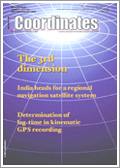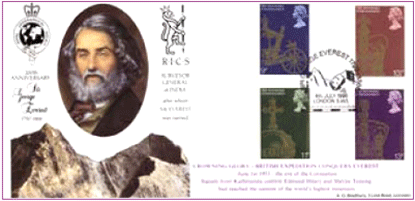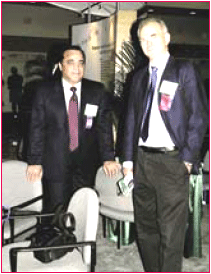EU’s transport chief eyes military use for satellite system
The European Union should consider employing its Galileo satellite navigation program for military uses in addition to the civilian purposes for which it was designed, the EU’s transport chief said. “Galileo was supposed to be a civilian system only but I wonder whether we shouldn’t question that,” Transport Commissioner Jacques Barrot told a conference in Luxembourg. “Using it for military purposes, for defence purposes … would be very interesting in terms of paying for the infrastructure and the
investment,” he said of the multi-billioneuro project.
www.defensenews.com
According to the reports published recently, ISRO plans to put an Indian in space by 2014 …
November 2006
Southeast Asian Geography Association Conference (NIE-SEAGA) 2006
28-30 November, Singapore
www.hsse.nie.edu.sg/staff/changch/seaga/seaga2006.htm
December 2006
The …

China’s GI industry to exceed $10 billion by 2010
The geographic information industry is a burgeoning and fast-growing industry. Statistics from overseas authoritative institutions show that since 2000, the annual growth rate of the geographic information industry has exceeded 25 percent. More and more large international enterprises, such as Microsoft and Google.com, have begun to enter into this field. According to a recent report published in the China Economic Net website China has proposed in the Outline of the 11th Five-Year Plan for National Economy and Social Development “to intensify the construction of infrastructures and facilities for surveying and mapping, enrich, develop and utilize the fundamental geographic information resources, and develop the geographic information industry”. The report further says that the total output value (based on incomplete statistics) of China’s geographic information industry reached RMB 26 billion Yuan (more than 3 billion USD) in 2005 and the industry is becoming a rapidly rising burgeoning industry among modern service industries and a new growth point for the economy. The annual total production value of China’s geographic information industry is expected to exceed RMB 80 billion Yuan (more than 10 billion USD) by 2010. http://en.ce.cn

US agency says China used laser to jam US satellite
China has beamed a ground-based laser at US spy satellites over its territory, a US agency says. The action exposed the potential vulnerability of space systems that provide crucial data to American troops and consumers around the world. The Defence Department remains tightlipped about details, including which satellite was involved or when it occurred. The Pentagon’s National Reconnaissance Office Director Donald Kerr has acknowledged the incident, first reported by Defence News, but said it did not materially damage the US satellite’s ability to collect information. “Space is a much bigger part of our military posture than it used to be, so any effort by the Chinese or anybody else to jam our satellites is potentially a big deal,” said Loren Thompson, Defence Analyst with the Virginia-based Lexington Institute. Clearly, the incident sparked fresh concerns among US officials about the US ability to determine if satellite problems are caused by malfunctions, weather anomalies like solar flares, or targeted attacks.
www.theage.com.au

India heads for Regional Navigation Satellite System DR ARJUN SINGH AND DR S K SARASWATI
The 3rd dimension DAVID JONAS AND NILS MATHEWS
Determination of Lag-time in Kinematic GPS
recording SREENIVASA RAO K AND JAYALAKSHMI I
Consumer-Grade GPS for efficient GIS and mapping applications R M MIKOL
Indian electronic navigational charts :
A digital journey RAJESH KUMAR

GPS coming to GSM handsets
After years of anticipation, GPS technology should finally arrive in a significant number of GSM mobile handsets in 2007, according to a new study by market research analyst ABI Research, USA. The report also says that 25 percent of WCDMA handsets will incorporate GPS by the end of 2008. The factors like government regulations covering location technology for emergency services such as E911 as well as a recognized demand for LBS will be responsible for the expected rise of GPS in GSM and WCDMA handsets, according to Alan Varghese, ABI principal analyst. www.eetimes.com













 (5.00 out of 5)
(5.00 out of 5)